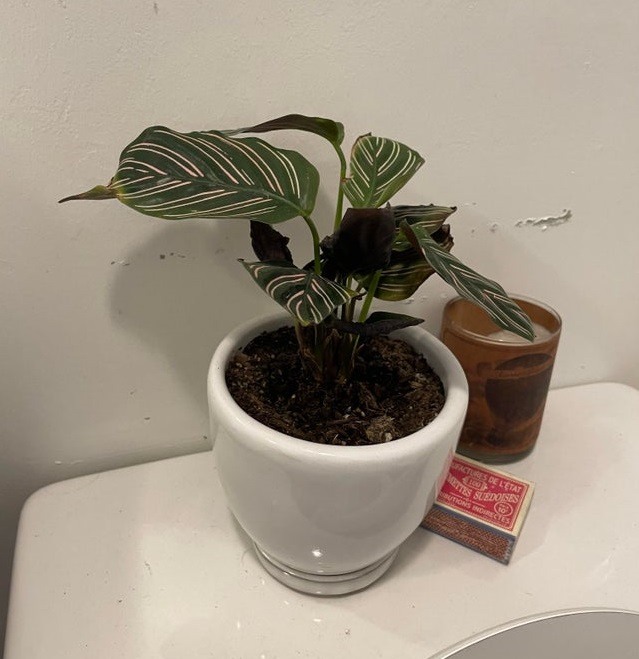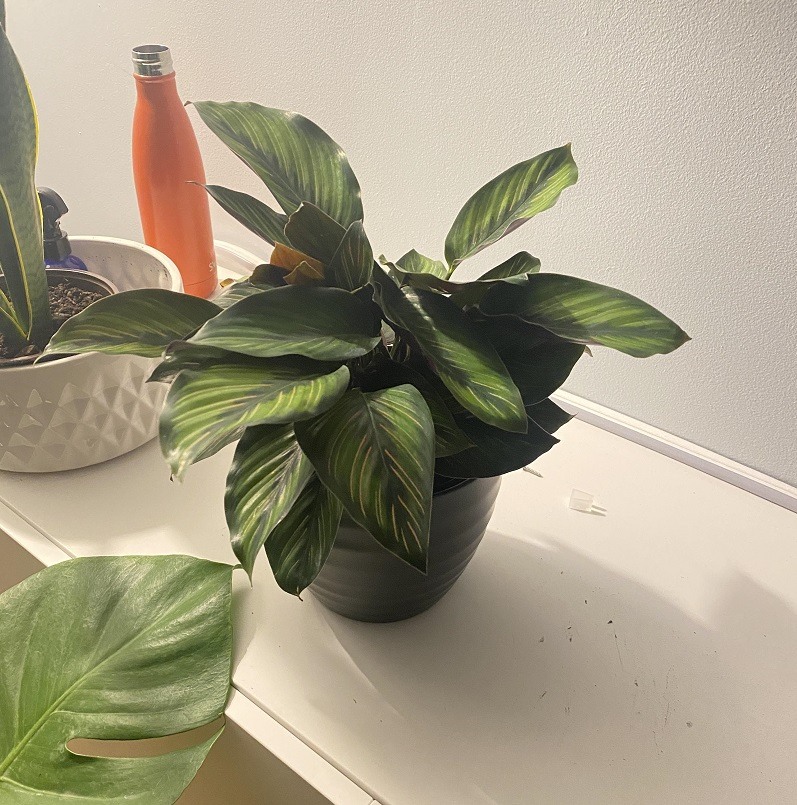Calathea ornate (pinstripe plant) was my first houseplant to grow and maintain. I struggled to keep this indoor plant alive and healthy. It can be fussy to handle despite having vibrant foliages that make a bold statement in many spaces.
Calathea ornate care involves the provision of bright indirect sunlight, high humidity, regular watering routine, well-draining soil, and a temperature range of 65-85oF. I also recommend feeding this houseplant monthly during the growing season.
Calathea pinstripe is a beauty with a lasting impression, and knowing her optimal growing conditions will keep the plant alive and healthy for many years. These calathea pinstripe care tips will make growing your plant easy and fun.
You Might Also Like: How to Care for Calathea Musaica Plant

What Does Calathea Ornata Looks Like?
Calathea ornate is also known as calathea pinstripe or pinstripe plant. The lustrous bands of colors are the reason behind the nicknames.
The perennial plant belongs to the maranta or prayer plant family and is native to South America. It is mostly grown in temperate climates as a houseplant.
The large, vibrant, and beautiful foliages with distinctive patterns make a lasting impression in any space. It is a perfect choice for adding to your indoor plant collection.
The tropical plant grows up to two feet tall under better indoor growing conditions. Besides that, the plant is a non-toxic species to cats, dogs, and toddlers.
Calathea ornata does not bloom despite providing sufficient light. But the lovely leaves and hues happen to be the reason behind its popularity in many American homes.
You May Also Like: Calathea Leaves Turning Brown and How to Fix
Calathea Ornata (Pinstripe Plant) Details
| Origin | Colombia, South America |
| Scientific Name | Calathea Ornata |
| Common Name | Pinstripe Plant Pinstripe Calathea |
| Light Requirement | Bright Indirect Sunlight |
| Watering Needs | Frequent Watering |
| Humidity | High humidity level of 50-80% |
| Soil Requirement | Light and well-draining potting soil |
| Temperature Range | 65-85oF (18-30oC) |
| Repotting | Once every two years |
| Fertilizer | Feed the plant every 4-6 weeks of spring and summer. |
| Propagation | Leaf cutting in spring |
| Pests and Diseases | Pests: Spider mites and Mealybugs Diseases: Leaf spot and Root rot |
| Pruning | Minimal pruning requirement |
| Blooming | Rare but grow spiral bracts |
| Toxicity | Non-toxic to pets and humans |
How to Care for Calathea Ornata (Pinstripe Plant)
Calathea Ornata Light Requirement
Calathea ornata is a tropical plant that grows under the canopy. It implies that the plant thrives under bright indirect sunlight in its native habitat.
Too little light will cause stunted growth, and prolonged bright direct sunlight will scorch its delicate leaves. Keep an eye on the leaves to note any changes when growing at home.
I recommend placing the houseplant near the east-facing window with a curtain or shade. The bright indirect sunlight will enable the plant to develop vibrant and beautiful foliages.
How to Water Calathea Ornata
Calathea pinstripe is not a drought-resistant houseplant. It is known to thrive in moderate soil moisture without becoming fussy.
Inconsistent watering habits and overwatering routines might harm your houseplant. A damp environment encourages the growth of fungus and other harmful molds.
Be sure to inspect the soil moisture level before watering. The care tip will help to keep the plant alive and healthy for a couple of years.
I recommend developing a strict watering schedule to keep your plant hydrated. But ensure there are gaps between the watering to avoid overwatering issues like root rot.
Water the houseplant twice or thrice every week in spring and summer. It is the period where the plant experiences active and vegetative growth.
Best Calathea Ornata Soil Mixture
Calathea ornata loves soil with moderate moisture. Every houseplant enthusiast needs to find well-draining soil with the ability to hold moisture.
Heavy and compact soil will make aeration challenging and cause plant suffocation in the long run. I recommend light and well-draining potting soil.
You can also consider soil with bigger chunks and moss. The potting soil will hold water and allow air to flow through it with ease.
Calathea Ornata Humidity Requirement
Calathea pinstripe is a tropical plant that thrives in a high humidity environment. But maintaining such humidity levels in the house can be challenging.
You can consider misting the leaves twice a week at room temperature to increase air moisture around the plant. But this is not the best option as it increases the risk of leaf spot disease.
I recommend keeping the houseplant in the bathroom or kitchen due to the natural humid condition. You will not need to keep track of the plant in the long run.
Another excellent option is to install a humidifier in the house to boost indoor humidity levels to meet the plant requirements. Install a digital hygrometer to detect humidity changes.
Best Calathea Ornata Temperature Range
Pinstripe calathea appreciates a warm and humid environment. The pinstripe plant thrives in a temperature range of 65-85oF (18-30oC).
Sudden temperature changes may harm your houseplant. Pay extra attention to the location of your houseplant to prevent damages due to temperature fluctuations.
Be sure to keep your houseplant away from cold and heat drafts. The conditions will make the pinstripe plant leaves curl, droop, and turn yellow or brown.
How to Fertilize Calathea Ornata
Calathea pinstripe plants are low feeders in terms of fertilizing. But the plant does benefit a lot from the fertilizer nutrients to enhance distinctive foliage patterns.
I recommend fertilizing the houseplant every four weeks in spring and summer. Be sure to use water-soluble and balanced fertilizer meant for houseplants.
Do not fertilize the indoor plant in winter since it won’t utilize the nutrients. Winter is the season where the plant experiences a dormancy stage.
Excessive fertilizer accumulation around the root systems will become toxic. The pinstripe plant foliages will develop brown patches and even begin to wilt.
You Can Also Read: How to Care for Oxalis Triangularis
How to Repot Calathea Ornata
Calathea ornata is less vulnerable to root-bound issues. But I recommend repotting the plant every 2-3 years or in case of over-fertilization and root rot.
Use the peat-based potting mix to pot and provide the ultimate care regime. Use a sterilized pruner to trim the roots with rot before transplanting.
Mist and water the houseplant more often after repotting to support healthy growth and root establishment. Be sure to provide sufficient indirect sunlight.
How to Propagate Calathea Ornata
Calathea ornate propagation is done through the division of the clumps of leaves and leaf stalks during repotting. The spring season is the best period to propagate the houseplant.
Ensure each clump has roots attachment for faster growth. Place the plant in a bright area and cover the pot with a polythene bag until new growths appear.
Pruning and Maintenance
Calathea ornata is vulnerable to brown leaves. But there is no need to freak as this is an indication for pruning and trimming.
Use a sharp pruner (Check Best Deals on Amazon) to remove the dead leaves and maintain a good growth pattern. Remember to wipe the foliages to remove dust and dirt to provide added vigor.
You May Also Enjoy: How to Care for Calathea Warscewiczii (Jungle Velvet)
Common Issues and Solutions
Pests
Calathea ornata is less vulnerable to pest infestations. But this does not mean the houseplant is invincible to insect infestations.
Spider mites, aphids, scales, fungus gnats, and mealybugs are the most common sap-sucking insects that attack this houseplant.
I recommend the use of a warm soap solution to eliminate the pests. Another excellent option is to consider an insecticidal soap solution (Check the Best Deals on Amazon).
Diseases
Root rot is the leading disease that affects calathea ornata. It occurs due to overwatering and improper soil drainage.
The condition is associated with leaves turning yellow, wilting, and stunted growth. Take the plant out of the pot gently and inspect the roots.
Roots with rot are marked with a brown and bushy appearance. Use a sterilized pruner to trim the affected parts and repot the plant to save them. Provide ultimate calathea ornata care.
Frequently Asked Questions
Is Calathea Ornata Toxic to Pets?
No. The calathea species is non-toxic to both pets and humans. But I recommend keeping the plant away from pets and toddlers to avoid destruction.
Why Is My Calathea Ornata Drooping?
Inconsistent watering habits and drafts are the leading cause of calathea ornata drooping. Dry soil causes plant dehydration and limping. Besides that, cold and hot drafts tend to harm pinstripe plants.
Why Are My Calathea Ornata Leaves Turning Yellow?
Low light conditions and malnutrition are the possible culprits behind calathea ornata leaves turning yellow. Other causes are overwatering and pest infestations.
The provision of better growing conditions will help to resolve the issues. Spray the houseplant with insecticidal soap to get rid of insects on the foliages.
Why Is My Calathea Ornata Dying?
Over-fertilization and root rot are the leading cause of the issue. The best option is to repot the houseplant and trim the root parts with rot.
Use fresh and well-draining potting soil. Remember to provide the best calathea ornate care to prevent the houseplant from dying.
Why Are My Calathea Ornata Leaves Pointing Up?
Under-watering is the main cause of calathea ornata leaves pointing up. It is a mechanism that helps the houseplant to conserve the remaining water.
Other possible causes are direct sunlight, low humidity, and overwatering. The best option is to identify the exact cause and try to fix it.
Difference between Calathea Sanderiana and Ornata
The main difference between calathea sanderiana and calathea ornata is that the former is bigger with broad and short foliages while the latter has large and elliptical dark green leaves with pink lines that radiates from the midrib.

Final Word
Calathea ornata is a fantastic houseplant for improving the visual appearance in any space. The tropical vibes will also boost your happiness and health.
The houseplant can remove toxic volatile organic compounds from the air. The mechanism helps to keep your indoor space fresh and healthier.
How to care for calathea ornata plants involves the provision of bright indirect sunlight, high humidity, regular watering, and an appropriate temperature range.
